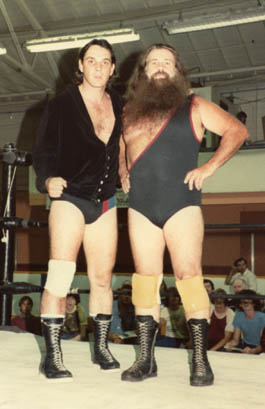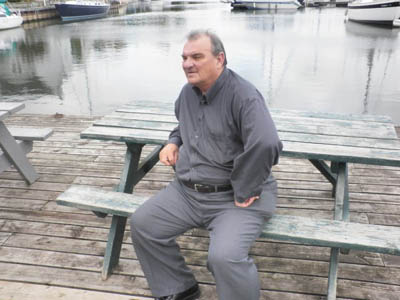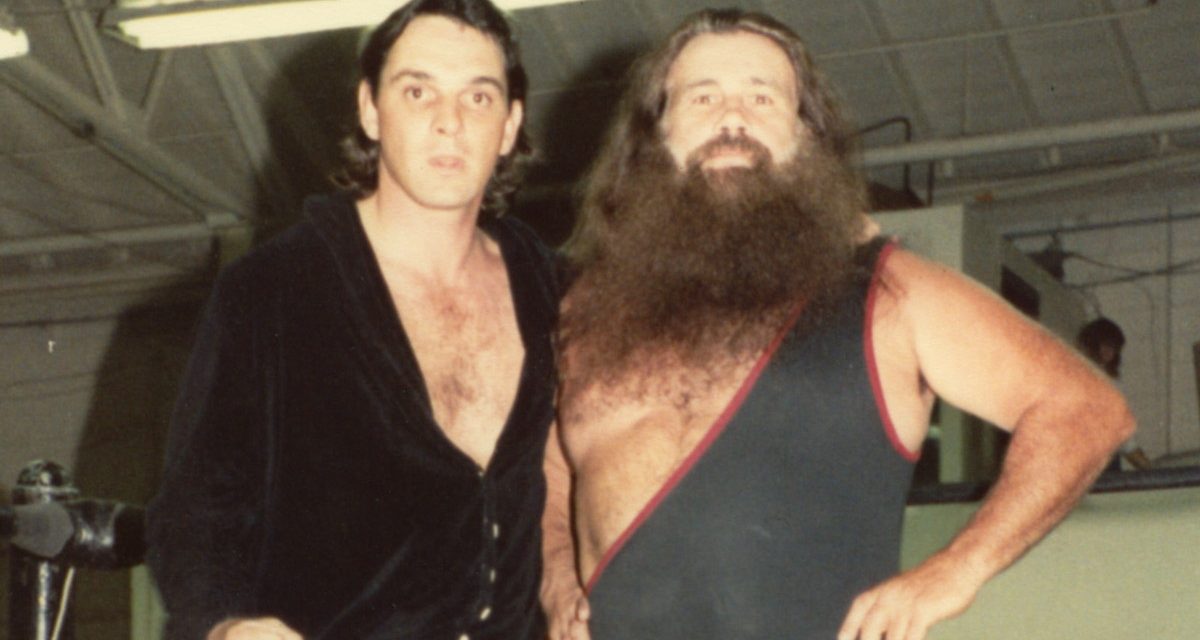If you saw Whipper Watson Jr. in Canada, then you saw the good guy; if you saw him wrestle somewhere else, it’s likely you saw a bad guy. After all, there’s no way the son of Canadian legend Whipper Billy Watson could ever heel at home. Except that one time…
Phil Watson, one of three children of The Whip, started helping his dad in the family business when he was 16, driving to the summer shows, setting up and tearing down the ring, and often refereeing the bear match.
But he’d been in the ring before that. When he was just 15, he got a chance to wrestle his friend Art in Sutton, Ontario, an impromptu little bout to kill some time. It was the first chance that Watson had to go bad.

Whipper Watson Jr. and “Bearman” Dave McKigney in 1981. Photo courtesy Terry Dart.
“We didn’t know anything. We just went in and put on a little tentative exhibition,” Watson recalled for SLAM! Wrestling. “I remember, it was funny because I came back, it was probably six minutes into it and I’d probably thrown 10 dropkicks and didn’t get any reaction out of the people. I said, ‘Wow, what do you have to do to get any reaction out of the people?’ There’s the pros in here getting all kinds of reaction. So I turned villain at that point, and I definitely took a verbal beating from my dad when I got back into the dressing room for having crossed the line.”
He’ll agree that his dad, who died in 1990, was the ultimate hero and it was a slap in his father’s face. “I just thought, I’ll be the ultimate villain. I’ll get some reaction out of these people — and I did; they booed me when I left the ring.”
Phil Watson was born in Toronto in 1949 to Bill and Patricia (nee Utting) Potts. The short version of The Whip’s life is that the Toronto native tried to break into wrestling in his hometown, but was shunned. He set off to the United Kingdom in a cattle boat to catch a break; he’d come home with a new name and a British wife.
His son shares the version of the story he was told. “He went over from here on a cattle boat. Whinnet Watson, who was Pat Flanagan, my dad, Hangman Bill Potts — my dad, Tommy Nelson and Tiger Tasker. They got over there and apparently, how my dad’s name got switched around, because there wasn’t TV or anything. Whinnet Watson, from what I understand, this is the way the story came down to me, he was at the top of the bill, but he either got sick or got an injury or something, so they needed Whinnet Watson. So all of a sudden Hangman Bill Potts switched over from Hangman Bill Potts to Whinnet Watson to fill that billing up. Actually, apparently it was a Japanese wrestler that taught him the move, the Irish Whip [demonstrates it while sitting down]. That’s where he became Whipper. Poor Whinnet Watson had to find a new name, so he became Pat Flanagan.”
Upon his return to Canada, the newly-christened Whipper Watson worked his way up the cards in Toronto until he was established as the best-known Canadian wrestler in history, thanks to the expansion of TV while he was still in his prime.
“The hardest thing for me growing up, at seven or eight years old, (was) acknowledging mail that would come through to the house and it would say William John Potts on it. I’d be going, ‘How could my dad be Potts, and I’m Watson?’ Because we were always brought up as Watson, we were never brought up Potts,” Phil Watson recalled, but doesn’t remember exactly when the family legally changed all their names. “As kids, my sister, my brother and myself, we always grew up as Watsons, so I don’t remember at what point that got changed. It must have been by the point we got to school anyway.”
So the choice to follow in his dad’s footsteps — big brother John had briefly wrestled as well, but never stuck with it — was indeed a big decision for Watson.
In a 1973 newspaper interview, he addressed the pressure.
“I did not have to make a name for myself in the wrestling world, it was already there,” Watson told a Peterborough, Ontario, newspaper. “It’s when I step into the ring that I sometimes feel uncomfortable because I try my hardest to live up to my dad’s reputation.”
After working the summer circuits while still in high school, the young Watson learned his trade quickly, and by age 18 was actually running an informal wrestling school on the grounds of the family’s farm in Keswick, Ontario.
Like his father before him, Phil got a chance to go to England to wrestle. That was 1970. He was 6-foot, 192 pounds at the time.
“I was 19 years old when I went to Manchester. I went there, actually out of Leeds, for George de Relwyshkow, and Art Brighton was the promoter for Manchester. When I was there, they took me to a gym called the Wigan gym,” he recalled. “It’s all shoot wrestling there. Well, I was used to doing all showmanship wrestling, and at 19, I thought I knew everything. So they took me there, and they said, ‘We’re going to grapple.’ I said, ‘Grapple? What the hell is grapple?’ Well, they made me tap out about four times in 45 seconds, and then I knew what the hell grappling was. I went, ‘Well, this ain’t no fun. I like the showmanship stuff.'”
In England, he worked against names such as Jackie Pallo, Les Kellet, and Mick McManus.
“I remember one of the experiences from there, it was the first real scary experience I had in the wrestling business,” he began. The crew went on a boat from Wales to Belfast, Ireland. “That’s when they still had all kinds of racial problems like they had back and forth there. They said, ‘You’ll be picked up at the boat and you’ll be taken directly to the hotel. Don’t leave the hotel. Everything you do, you do inside the hotel. You do not go out on the street at all. You’ll be picked up by a taxi when it’s time for your match, and you’ll be taken to Royal Ulster Hall. Then from there, don’t even get a shower or anything. As soon as your match is over, you gather your clothes. Don’t even change. You take your clothes, little suitcase and stuff, and you go — there will be a fella there — you go directly to the taxi and back onto the boat.’ They told us, ‘Do not go on the street there.’ That was just scary, to even get up and go.”
He adapted quickly to the different style in England. “Your matches would be best two falls, two submissions, or one knockout to decide the winner. There was a public warning if you hit somebody when they are down. The referee stops the match, ‘One public warning is awarded against so-and-so.’ And you get three public warnings. I mean, for heat over there, if the guy was getting up, and all you had to do was hover over him like this — don’t touch him, but hover over him; you’re just waiting until the guy straightens his back out, where he’s legally standing, then you smash him back down again,” he demonstrated. “You never did anything like pull a gimmick out of your tights or anything like that.”
Watson is glad he went, but regrets not taking the opportunity to work in Germany or Spain or other places on the Continent.
“It was a real good, eye-opening experience that I went over there, that I was 19 and thought I knew everything about the wrestling business,” he said. “I mean, I knew more than the legends knew when I was over there. And I found out really quick that I didn’t know anything.”
In the early 1970s, Watson got to wrestling in Mexico as well, working for Salvador Lutteroth Jr.
“I couldn’t believe what a factory it was. When you were not, if you were off for a day, you were expected to be at the Arena Mexico upstairs training,” he explained. “I saw guys, they depended on this for their living. I saw guys that were there lower on the card that, it was funny, you went to like a banker’s cashier thing, it probably wasn’t any wider than from the bed to there; it was a ticket window that you went up to. You gave them your name and you received your pay. You did that two times a week. You also got your bookings for the following week. You’d see guys that hadn’t gone to the workouts and that, if you missed two workouts, you probably didn’t work the next week at all. But everywhere in Mexico at that time, at least at the time, ran shows during week, but everybody ran shows on Sunday. I don’t know how they had enough wrestlers, but every single town ran on Sundays. In Mexico City on a Sunday, there would be as many as 21 different wrestling shows in all the little bull arenas. The bigger shows were the Arena Coliseo, which seated about 7,000 people. That would run Monday, Wednesday, Sunday, and then the Arena Mexico ran Friday nights, which was about 25,000.”
The passionate fans are a particular memory for Watson, who never wore a mask while wrestling the lucha libre style against big names like the Villanos, Rayo de Jalisco, Dr. Wagner, and Angelo Blanco.
“It was cheap entertainment. I wrestled on cards with maybe 18 guys on the card, and there would only be two of us without a mask on,” he said.
For someone whose father was so establishment, a former NWA World champion, part owner in the Toronto and St. Louis offices at various times, it is surprising how his son took to rebel promotions.
When Eddie Einhorn bailed on his plan for a national promotion in 1975-76, Buffalo promoters Pedro Martinez and Johnny Powers stepped in, attempting to run shows in the Carolinas. The Toronto-Buffalo connection between promotions had always been strong, and Watson loved his time there. “That was one of my greatest experiences, working with Pedro Martinez.”
After a brief attempt to promote in Winnipeg in 1973 — a story for another day — Watson hit the road, dragging good friend Rachael Dubois, the teenage stepdaughter of Dave “Bearman” McKigney, along for the trip.
One of the first places Watson and Dubois went in the U.S. was Nashville, Tennessee for “Uncle” Nick Gulas, which was renowned for poor paydays, and Atlanta for Ann Gunkel’s promotion, which she had taken over after the sudden death of her husband, Ray, and was competing against a united NWA, which wanted to continue to control the area. Watson said he went to Gunkel because Tom Renesto was booking. “Tom used to be fun in and of himself too. He was about half blind,” he recalled. “Guys used to do it just to get him to take his booking book out, he’d almost have his nose on the paper and be looking, ‘Wednesday, you’re in Augusta, Georgia.'”
Dubois still shudders at the memories. “The worst part of my career? Padutka, Kentucky. Drive five hours to there for a match for 25 bucks. Drive five hours back. I had a car then, so I could charge for trans, for gas money.”
The friends went way west to Dean Silverstone’s Superstars of Wrestling promotion, another outside-the-mainstream company. There, Dubois bailed. “I called my dad. ‘I’m coming home. Can you send me the license stickers?’ That was the year, instead of a new plate, you put a sticker. So I drove back, by myself, from Seattle, Washington, back to Toronto with a fake sticker that I put together with red nail polish!”

Phil Watson spins tales in the fall of 2009 in Picton harbour. Photo by Shuhei Aoki.
Watson didn’t give up on his dream, however. In Nashville, he’d befriended Roy “Ripper” Collins, and they went to Hawaii together in 1979, with Whipper billed as his cousin Ripper Watson. “I was the guy who played kind of the dumb part. He did all the big wrestling parts,” Watson explained. “He would go, ‘Cousin, cousin, where are we wrestling this week?’ I’d go, ‘I don’t know.’ He’d go, ‘Remember the town that sounds like the cow.’ ‘Oh yeah, Moo… Moo… Mooee.’ Instead of Maui, I’d say Mooee. Then he’d say, ‘What’s H-I spell?’ I’d go, ‘Hi?’ He’d go, ‘What’s L-O spell?’ I’d say, ‘Low.’ ‘So where are we wrestling?’ I’d go, ‘Oh yeah, Hilo.’ Hilo instead of HeeLow. Cheap heat.”
The lax schedule, where the wrestlers only worked a couple times a week, was great, he said, but he could see that the Ed Francis-run promotion was struggling. “It was so-so. But everybody, all the big stars that would come while going to Japan, because Japan was THE place to go when you did a tour, they’d all stop for three days, four days flying on the way to Japan, and then stop over at the end of their tour for a few days after. That’s when they ran the big HIC shows.”
Watson’s mother and aunt once came to visit in Hawaii, and he and Ripper worked out a rib on her. They both had bleached blond hair, though Mrs. Watson hadn’t seen her son in a while. Watson pointed out his mom to Ripper, who had no fear. “I hid behind the pillar and went, ‘That’s her there Larry.’ Larry goes, ‘Ma, how are you?’ She went ‘Help!'”
All the traveling really shaped the Phil Watson that many Ontarians know, from the small-town circuit around the province every summer.
He was always respected by his peers for being a good technical wrestler. “I was always trying to experiment with different things. I think a lot of it was maybe stuff that I picked up in England, or I picked up in Mexico, and I’d bring it into Canada or the United States, and put my own spin on things.”
— with files from Shuhei Aoki
RELATED LINK

